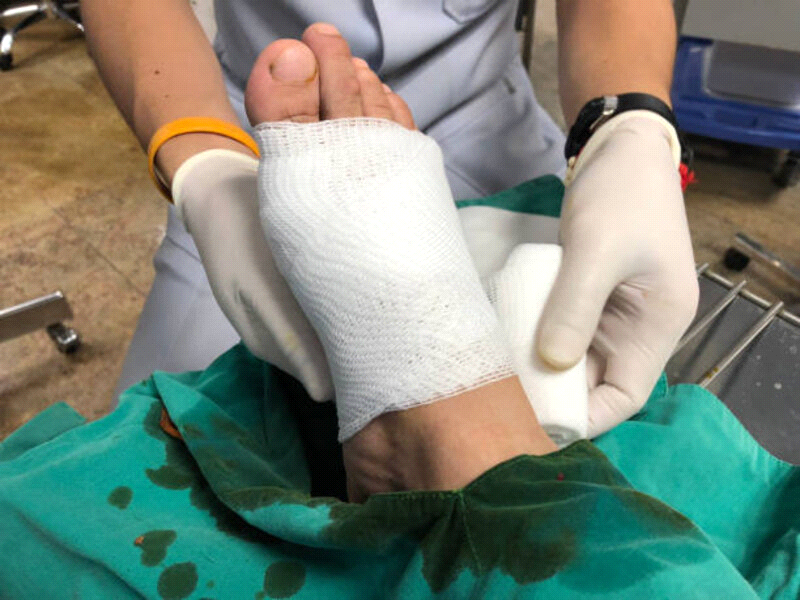Comprehensive Guide to Plantar Fasciitis Treatment Options
Jan 21, 2024 By Madison Evans
Plantar fasciitis is a common condition that causes pain and inflammation in the heel and bottom of the foot. If you're suffering from plantar fasciitis, you're probably wondering how to find relief and get back on your feet. In this blog post, we will explore various treatment options that can help alleviate the symptoms and promote healing.
1 .Physical Therapy

Physical therapy plays a crucial role in the treatment of plantar fasciitis. It focuses on reducing pain, improving flexibility, and strengthening the muscles and ligaments in the foot. Your physical therapist may recommend the following exercises and techniques:
Stretching Exercises:
Stretching the calf muscles and the plantar fascia itself can help reduce tension and relieve pain. These exercises are often performed multiple times a day.
Taping and Braces:
To provide extra support to the plantar fascia, your physical therapist may recommend taping it in a specific way or using a brace. This helps to reduce the strain on the tissue and can provide extra comfort during activities like walking or running.
Massage and Manual Therapy:
Manual techniques such as;
- Massage.
- Myofascial Release.
- Joint Mobilization.
These can help improve;
- Circulation.
- Reduce Inflammation.
- Promote Healing.
Strengthening Exercises:
Strengthening the muscles that support the arch of the foot can help alleviate stress on the plantar fascia. Your physical therapist will guide you through exercises targeting these specific muscle groups.
2 .Orthotics and Supportive Shoes
Orthotics and supportive footwear can provide additional support and cushioning to the foot, helping to relieve pain and prevent further damage to the plantar fascia. Some treatment options in this category include:
Custom orthotics:
These are specially made-shoe inserts that are designed to support the arch and correct any biomechanical issues that may be contributing to your plantar fasciitis. Custom orthotics are tailored to your specific foot shape and can provide significant relief.
Supportive footwear:
Wearing shoes with proper arch support, cushioning, and stability is essential for managing plantar fasciitis. Look for shoes that have a firm heel counter, a supportive midsole, and good shock absorption.
3 .Medications
Medications can be used to manage the pain and inflammation associated with plantar fasciitis. Your healthcare provider may recommend the following:
- Nonsteroidal anti-inflammatory drugs (NSAIDs): NSAIDs such as ibuprofen or naproxen can help reduce pain and inflammation in the affected area. These medications are available over-the-counter or in prescription strength.
- Pain relievers: In some cases, your doctor may prescribe stronger pain medications to help manage severe pain caused by plantar fasciitis.
4 .Steroid Injections
For more severe cases of Plantar Fasciitis, Corticosteroid Injections may be recommended. These injections deliver powerful anti-inflammatory medication directly to the affected area, providing rapid pain relief. However, it's important to note that steroid injections are typically used as a short-term solution and should not be relied upon as a long-term treatment option.
Risks and Side Effects of Steroid Injections
While steroid injections provide rapid and effective relief from the pain and inflammation of plantar fasciitis, it is essential to understand possible risks and side effects associated with this treatment option. Some of the potential side effects include:
- Pain and swelling at the injection site: The area where the injection was administered may become painful and swell up immediately after the procedure. This reaction is generally temporary and subsides within a few days.
- Weakening of tissues: Prolonged use of corticosteroids can weaken tendons and ligaments in the foot, increasing the risk of future injury.
- Skin discoloration: Some people may experience changes in skin color at the injection site.
- Hyperglycemia: For individuals with diabetes, steroid injections can raise blood sugar levels, requiring close monitoring.
5 .Surgery

Surgery is usually considered a last resort when conservative treatments have failed to provide relief. Surgical procedures for plantar fasciitis aim to release tension in the plantar fascia or correct any underlying foot abnormalities. It's important to discuss the risks, benefits, and recovery process with your doctor before considering surgery.
Types of Surgery
If conservative treatments have not been successful, surgical intervention may be an option to consider. There are principally two types of surgeries for plantar fasciitis:
- Plantar Fascia Release: This is the most common type of surgery for plantar fasciitis. In this procedure, the surgeon partially detaches the plantar fascia from the heel bone to relieve tension and reduce inflammation. This procedure has a high success rate, but it can lead to complications such as a weakened foot arch.
- Gastrocnemius Recession: If you have limited flexibility in your calf muscles, a gastrocnemius recession can help. This is a procedure that involves lengthening the calf muscles to increase ankle motion and reduce strain on the plantar fascia.
Risks and Complications
Like any other surgery, plantar fasciitis surgery carries some risks and potential complications.
- These include nerve damage, infection, and a possibility that the surgery will not relieve the pain.
- Surgery can even lead to other foot problems such as flat feet due to the loss of arch support.
- It's crucial to have a thorough conversation with your doctor about the potential risks and benefits before deciding on surgery. Surgery should always be the last resort after all conservative treatment options have been explored.
Conclusion
Early treatment and seeking professional help are crucial when dealing with plantar fasciitis. The treatment options mentioned in this blog post can help alleviate pain, reduce inflammation, and promote healing. Remember, everyone's journey with plantar fasciitis is unique, so it's essential to work closely with your healthcare provider to develop a personalized treatment plan that suits your needs. Don't let plantar fasciitis hold you back from enjoying a pain-free and active lifestyle.
-
 Aug 01, 2024
Aug 01, 2024Using Kojic Acid Soap for Dark Spots
Learn how to use kojic acid soap effectively to reduce dark spots and acne for clearer skin.
-
 Jul 09, 2024
Jul 09, 2024Transform Your Leftovers: Delicious Ham Recipes
This article offers a range of delicious recipes to transform leftover ham into hearty, refreshing, and comforting dishes, ensuring no food goes to waste.
-
 Nov 09, 2023
Nov 09, 2023The Alarming Rise of Cancer Cases in Individuals Under 50
This explores the alarming increase in cancer cases among young adults, its impact on the healthcare system, and strategies for prevention and affordable care.
-
 Feb 14, 2024
Feb 14, 2024Understanding Blood Cancer: A Closer Look at its 3 Main Types
Dive into the three main types of blood cancer: leukemia, Hodgkin’s lymphoma and multiple myeloma. Understand their causes, symptoms, and treatment options.
